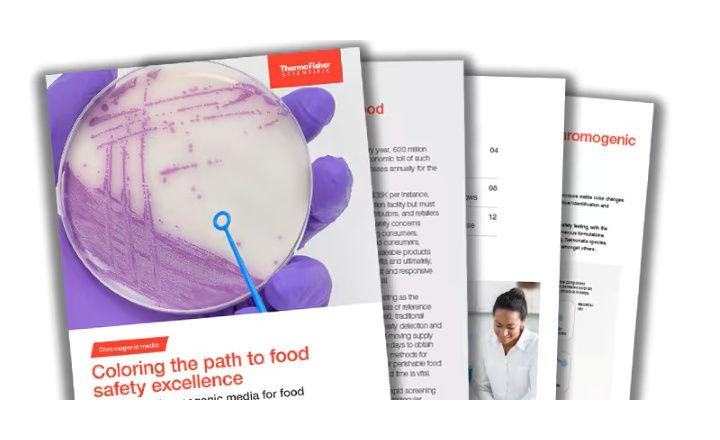
By Dr Paul Gibbs - Leatherhead Food Research/emeritus
 Listeria remains a profound problem in Europe and the USA. The UK Food Standards Agency identified Listeria monocytogenes as a ‘priority for action’ in light of the high number of cases and mortality rates associated with infection. Any evidence of L. monocytogenes in a food or beverage product can prompt immediate product recalls, as highlighted by recent recalls of cheese in the UK, but categorising all forms of L. monocytogenes as the same organism might be preventing us from actually understanding and eliminating the pathogen. New research shows that not all strains of L. monocytogenes are the same, with some types more likely to cause infection than others and certain types more likely to persist within food environments than others. So where should we target our efforts and why?
Listeria remains a profound problem in Europe and the USA. The UK Food Standards Agency identified Listeria monocytogenes as a ‘priority for action’ in light of the high number of cases and mortality rates associated with infection. Any evidence of L. monocytogenes in a food or beverage product can prompt immediate product recalls, as highlighted by recent recalls of cheese in the UK, but categorising all forms of L. monocytogenes as the same organism might be preventing us from actually understanding and eliminating the pathogen. New research shows that not all strains of L. monocytogenes are the same, with some types more likely to cause infection than others and certain types more likely to persist within food environments than others. So where should we target our efforts and why?
With a mortality rate of 20-30% (higher than the mortality rate for Salmonella and Campylobacter combined), the discovery of Listeria monocytogenes in a food or beverage product is considered a serious breach of food safety. Unlike Campylobacter which causes illness across all population groups, L. monocytogenes is particularly dangerous to those with reduced immunity. Those most at risk of infection are pregnant women, unborn and newborn babies, people aged over 60 years and people with medical conditions.
If you look for it, L. monocytogenes can actually be found everywhere. It can be very difficult to eliminate the pathogen because it is a good survivor, prospering in several natural environments, including waters, soils, plants and animals. The typical methods that manufacturers use to control microbial growth have been proven not to be successful in the control of L. monocytogenes. Physico-chemical means (e.g temperature, pH and salt) are not successful because L. monocytogenes is capable of growth at temperatures as low as 2°C, and under high salt, low pH values. This means it is very difficult to design a safe food product that will inhibit growth of the pathogen, and still retain sensory characteristics acceptable to the consumer.
The key tool manufacturers have up their sleeves to control listeria is heat treatment. The organism is not particularly heat resistant and can be eliminated by conventional pasteurisation. The options for eliminating the pathogen from food and beverage products which cannot be pasteurised, however, can seem rather thin on the ground.
It is no surprise that recent outbreaks have been most commonly associated with raw and unpasteurised foods, including semi-preserved meats and fish (e.g. ready-to-eat and delicatessen products such as patés, frankfurters, cold-smoked fish), cheese, especially soft and mould-ripened cheeses, ice cream, raw vegetables and salad items.
In light of the seriousness of the disease, regulation around listeria has traditionally been stringent. Many countries, such as the USA and Russia, have a zero tolerance for the presence of L.monocytogenes i.e. if the organism is detected within a product, then it must be recalled. Current legislation in Europe does allow for the presence of some L.monocytogenes. For Ready to Eat (RTE) products that are able to support the growth of L.monocytogenes, there should be no detectable L.monocytogenes at the point of manufacture, but small traces of L. monocytogenes are acceptable in these kinds of products at the end of their shelf life, as long as the numbers do not exceed 100 cfu/g.
While legislation is concerned with protecting the consumer, the current approach may actually be preventing us from understanding and eliminating the pathogen. Listeria legislation does not currently differentiate between different strains of L. monocytogenes, lumping all strains together as a single group of pathogenic organisms. The picture, however, is much more complex than this and attempting to address this complexity might assist efforts to eliminate the pathogen.
It is now recognised that not all strains of L. monocytogenes cause disease. Pathogenicity (the ability of an organism to cause disease) for humans is generally confined to certain strains of L. monocytogenes. One particular strain causes 40% of foodborne outbreaks.
Current research is now focussing on understanding why certain strains of L. monocytogenes are more pathogenic than others. Research has revealed that certain genes are more commonly found in pathogenic strains of L. monocytogenes and are absent in less pathogenic strains. This may eventually allow the development of tests to further distinguish pathogenic and non-pathogenic strains. However, this is complicated since the severity of disease i.e. virulence, is linked to individual immunity and certain people are more likely to contract listeriosis than others.
Whole genome sequencing, which shows scientists a pathogen’s complete DNA makeup, will in time enable us to develop greater knowledge about the pathogenicity of different strains of L. monocytogenes. This, coupled with a greater understanding of why certain people are more susceptible to L. monocytogenes, will enable us to take a much more nuanced approach to dealing with L. monocytogenes, and ultimately limit the number of listeriosis outbreaks.
 Leatherhead Food Research is bringing together key scientists, industry stakeholders and the Food Standards Agency to discuss practical strategies for listeria management in our ‘Taking Control of Listeria’ conference on 28th April 2016.
Leatherhead Food Research is bringing together key scientists, industry stakeholders and the Food Standards Agency to discuss practical strategies for listeria management in our ‘Taking Control of Listeria’ conference on 28th April 2016.
Catherine Brown, Chief Executive of the FSA, will be the key note speaker highlighting the responsibilities manufacturers have to protect consumers, especially in light of new UK sentencing guidelines. Professor Haley Oliver from Purdue University USA will present her state of the art published research on the whole genome sequencing of L. monocytogenes and how this is shaping our understanding of pathogenic and non-pathogenic strains.
The day will also cover practical advice for manufacturers from Dr John Holah on how to control listeria and Alec Kyriakides, Head of Product Quality at Sainsbury’s with the retailer perspective.
Book your space on the conference to join the debate and help shape the direction of future research and regulation.
About the author - Dr Paul Gibbs was Head of Food Microbiology and Special Projects Advisor in Leatherhead Food Research from 1978 – 2002 and remains as an emeritus consultant.






















